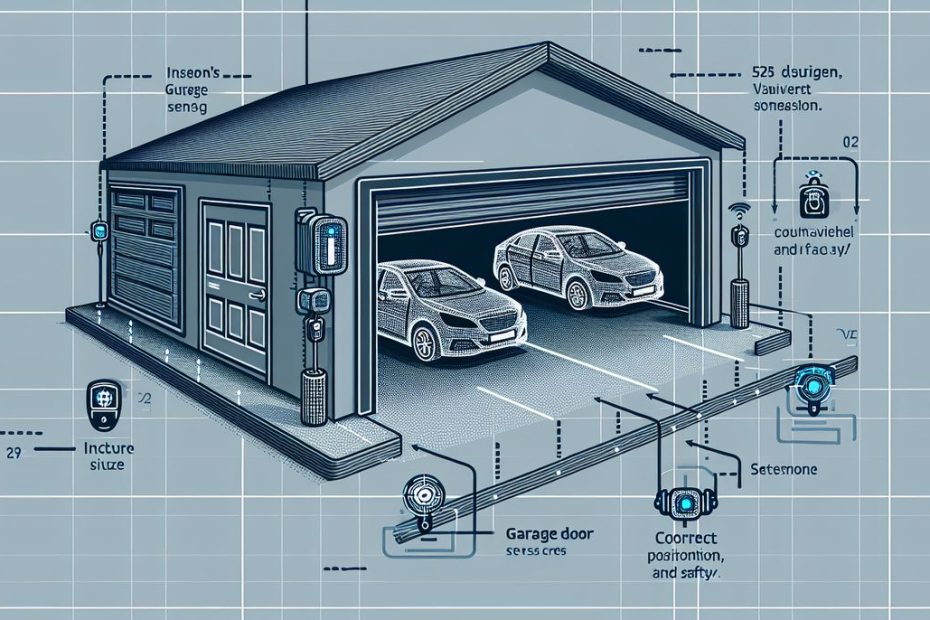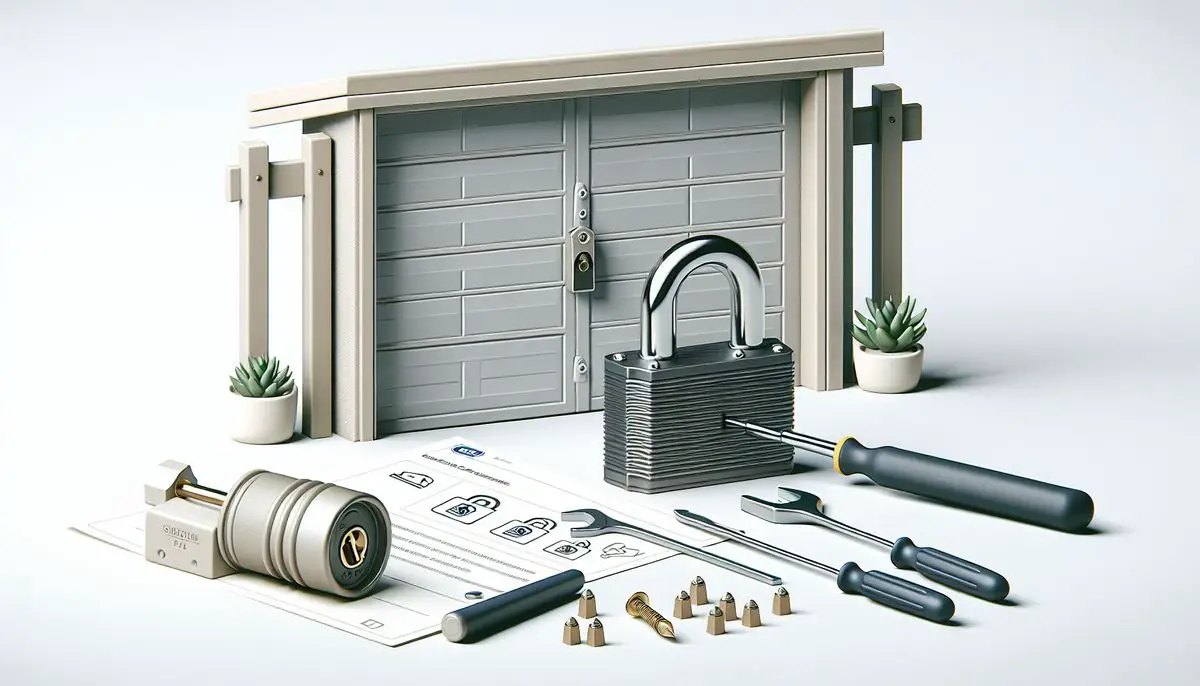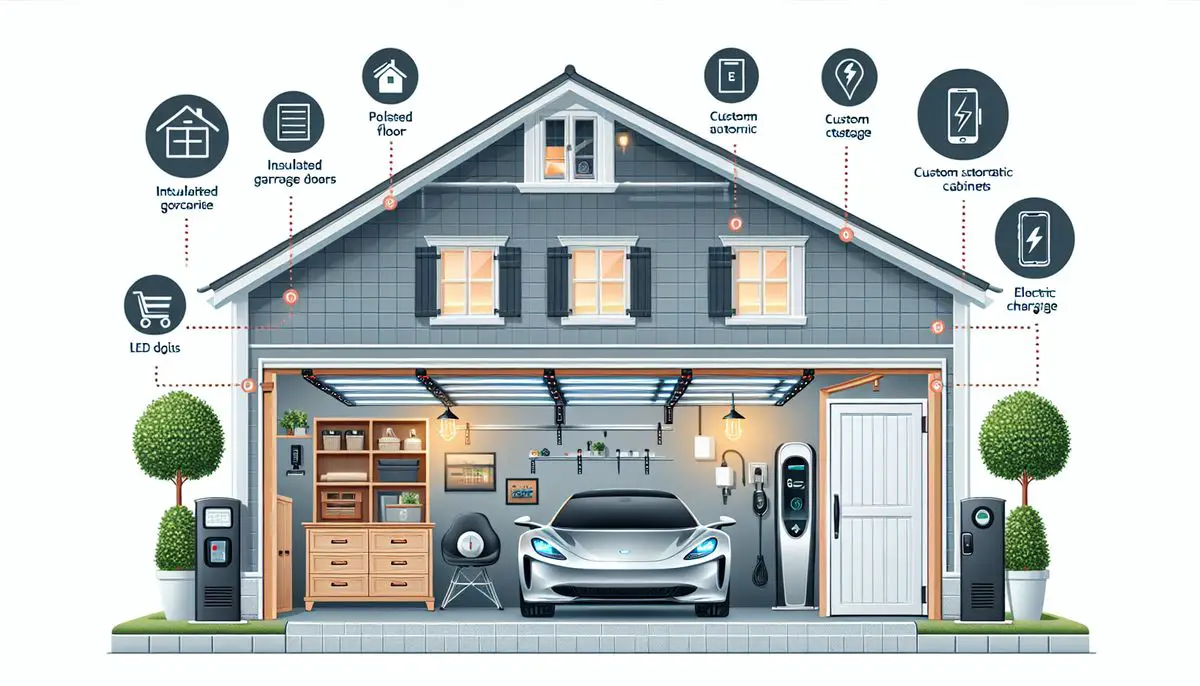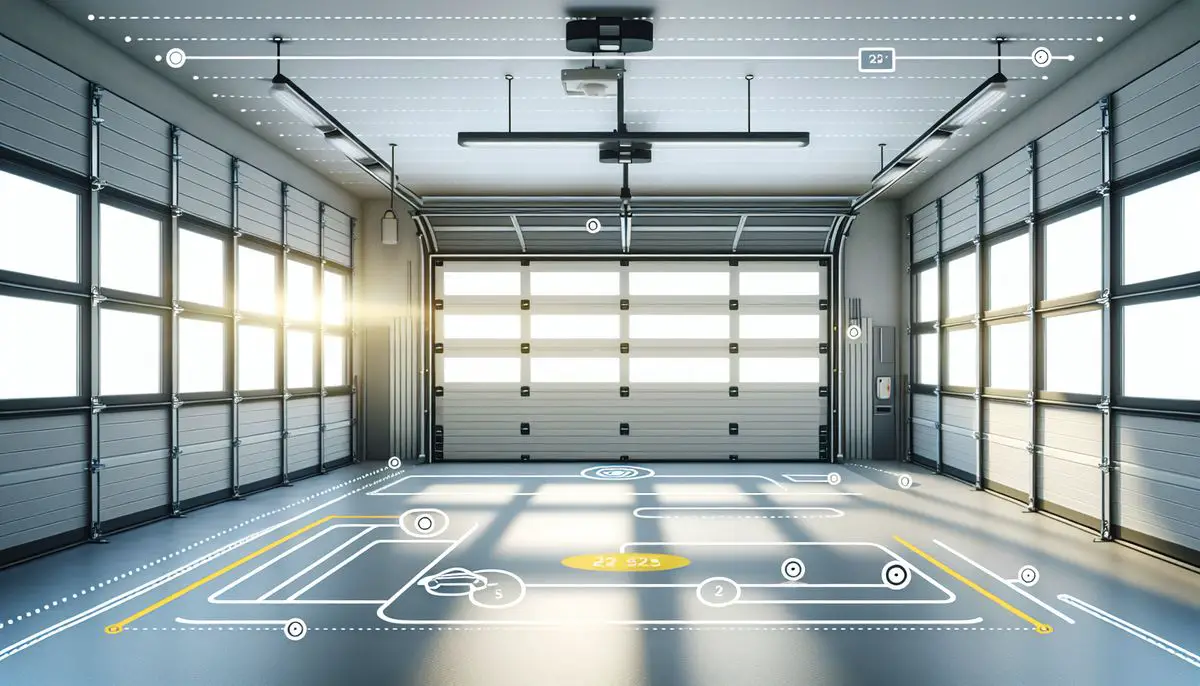In the modern home, the garage door is an essential feature that provides security, convenience, and smart home integration. Central to its operation are the garage door sensors, which play a critical role in safety and functionality. Proper alignment and maintenance of these sensors are paramount to ensure that your garage door operates smoothly and safely. This guide offers a comprehensive look at how to position your garage door sensors correctly, addressing common challenges and providing practical solutions to maintain precision and safety.
Key Takeaways
- Garage door sensors must be correctly aligned and free from obstructions to ensure safe and proper door operation.
- Regular maintenance, including cleaning and visual inspection, is crucial for optimal sensor performance and longevity.
- Testing sensor alignment is vital after any adjustments to confirm that the door functions correctly and safety mechanisms are engaged.
- Understanding the technology behind sensors and their integration with smart home systems can enhance overall garage door safety and efficiency.
- When persistent sensor issues occur, it is often best to seek professional assistance to prevent further complications and ensure accurate troubleshooting.
Understanding the Role of Garage Door Sensors
The Importance of Sensor Alignment
We understand that proper sensor placement in garage doors is crucial for safety. The alignment of these sensors is not merely a technical detail; it is a fundamental aspect that ensures the seamless operation of the garage door system. Misaligned sensors can lead to false detections or, worse, a failure to detect an actual obstruction, posing a significant risk to vehicles and individuals.
To achieve precise alignment, we follow a systematic approach:
- Prepare the area around the sensors, ensuring no obstructions.
- Clean the sensors thoroughly to remove any potential interference.
- Adjust the sensors horizontally and vertically to face each other directly.
- Test the alignment by checking the sensors’ response to obstructions.
It is our responsibility to maintain the integrity of the safety mechanisms in place. Regular maintenance and professional installation are key practices that reduce risks and enhance the security features of our garage door systems.
By adhering to these steps, we not only uphold the functionality of the sensors but also reinforce the overall safety of our homes. It is essential to remember that the alignment of garage door sensors is not a ‘set and forget’ task. Continuous inspection and adjustment are necessary to ensure uninterrupted operation and safety.
Sensor Technology and Safety Mechanisms
In our pursuit of a safer home environment, we have witnessed a significant advancement in garage door sensor technology. These sensors are not merely accessories; they are vital components that enhance the safety of our homes, particularly for those with children and pets.
Modern garage doors are equipped with infrared sensors that project an invisible beam across the doorway. Should anything disrupt this beam—be it a playful child, a wandering pet, or an unexpected obstacle—the door will halt or reverse its movement. This feature is a cornerstone of garage security, ensuring that our loved ones and belongings are protected from potential harm.
Furthermore, many garage doors incorporate pressure-sensitive edges that respond to physical contact. When these sensors detect pressure from an object, they trigger the door to stop and reverse, adding an extra layer of accident prevention. We must recognize that these safety sensors not only ensure legal compliance but also serve as guardians against accidents.
In addition to their primary safety function, these sensors can be integrated with home security systems, offering a comprehensive approach to both safety and security. By doing so, we can utilize our garage space for additional storage without compromising on safety.
To maintain these safety mechanisms at peak performance, regular inspection and cleaning are essential. We must be proactive in identifying and removing any obstructions that could interfere with sensor operation.
Integration with Smart Home Systems
We recognize the growing importance of integrating garage door sensors with smart home systems, not only for the convenience they offer but also for the enhanced security and efficiency they provide. Smart technology integration is a critical aspect of modern garage door systems, allowing for remote monitoring and control through dedicated smartphone apps. This feature is particularly beneficial for those moments when uncertainty strikes about whether the garage door was closed.
Our guide to selecting and maintaining garage door sensors emphasizes the need to consider compatibility with existing smart home systems. Here’s a brief overview of the integration capabilities:
- Compatibility: Ensure that the garage door sensors are compatible with systems like Hubitat and SmartThings.
- Remote Access: Look for the ability to monitor and control the garage door remotely, adding a layer of convenience.
- Security Features: Opt for systems that offer customized PIN codes and encrypted communication for increased safety.
By integrating garage door sensors with smart home systems, we not only streamline daily routines but also fortify our homes against potential security breaches. The integration with larger home security systems adds an additional layer of protection, which is crucial in ensuring residential safety.
In areas where safety is of utmost concern, the ability to connect sensor technologies with home security systems is invaluable. This integration not only contributes to the safety of our homes but also to the energy efficiency and construction quality, as modern garage doors are now designed to be more energy-efficient.
Inspection and Cleaning of Safety Sensors
Routine Sensor Maintenance
We understand the critical nature of garage door safety sensors in our daily lives. Regular upkeep of these safety devices is vital, ensuring they function correctly and effectively. An essential part of this maintenance involves cleaning the sensors and surrounding area regularly to prevent dirt or debris buildup that could interfere with their operation. Addressing any issues promptly is crucial for the continued safe and proper operation of your garage door.
To maintain optimal sensor performance, we adhere to a structured maintenance routine:
- Alignment: Ensure the sensors are facing each other directly and aren’t misaligned.
- Cleanliness: Keep the sensors free from dust, dirt, and debris.
- Obstruction-Free: Confirm there are no objects blocking the sensors’ path.
- Testing: Regularly test the sensors to verify they detect obstructions and reverse the door accordingly.
Preparing for sensor maintenance is as important as the alignment itself. Before any adjustments, ensure that there are no obstructions blocking the sensors’ line of sight. Use a clean cloth or a mild cleaning solution to wipe the sensors, removing any dirt or debris that may be obstructing them.
Identifying and Removing Obstructions
In our quest to ensure the safety and functionality of garage door sensors, we must pay close attention to potential obstructions. First, determine whether an object is blocking the sensors. This step is fundamental, as obstructions can trigger false readings or prevent the sensors from detecting actual hazards. We recommend a systematic approach to identifying and removing these impediments.
- Inspect the area around the garage door and remove any objects, such as toys, tools, or debris.
- Clean the sensors with a soft cloth to remove dust, dirt, or cobwebs that may interfere with their operation.
- Use a level to check that both sensors are parallel and at the same height, ensuring they are facing each other directly.
TEST DOOR MOVEMENT CAREFULLY after clearing any obstructions and cleaning the sensors to confirm their proper functioning.
By maintaining an obstruction-free path for the sensors, we not only enhance their performance but also uphold the safety mechanisms designed to protect property and individuals from harm.
Cleaning Techniques for Optimal Performance
To maintain the efficacy of our garage door sensors, we must adhere to proper cleaning techniques. Avoid using WD-40 or grease on moving parts, as these substances can attract dirt and debris, which may lead to further complications. Instead, we recommend using a silicone-based lubricant, which not only prevents rust and corrosion but also extends the lifespan and enhances the performance of the sensors.
When applying lubricant, it is crucial to use products specifically formulated for garage door components. This ensures compatibility and optimal functionality, keeping the door opener working seamlessly. Here is a simple list to guide you through the lubrication process:
- Use a high-quality silicone-based lubricant.
- Apply sparingly to avoid attracting dirt.
- Focus on pivot points and rollers.
- Wipe away excess to maintain cleanliness.
By adhering to these cleaning and lubrication techniques, we not only ensure the smooth operation of our garage door sensors but also contribute to the overall safety and longevity of the door mechanism.
It is also important to recognize when to seek assistance from professionals. Professional garage door services ensure safe and efficient installation, maintenance, and repair with expert handling of parts and use of proper tools and equipment.
Aligning Sensors for Optimal Performance
Visual Inspection for Proper Alignment
We begin our alignment process with a meticulous visual inspection to ensure the sensors are positioned correctly. This involves checking that the sensors face each other directly, with no misalignment that could hinder their functionality. It’s crucial to verify that the LED lights on each sensor are steady, which signifies proper alignment and power reception.
To facilitate this, we follow a structured approach:
- Prepare for Alignment: Clear the area around the sensors of any obstructions and clean them thoroughly.
- Check Sensor Alignment: Look for steady LED lights to confirm the sensors are aligned.
- Align Sensors Horizontally: Adjust the sensors using a level to ensure they are parallel and at the same height.
Remember, for safety codes, keep these sensors within six inches from the ground to prevent any small objects or uneven surfaces from disrupting the sensor’s beam.
After these steps, we conduct a series of tests to confirm that the sensors are responsive and reliable. This includes waving an object in front of the sensors while the door is closing to ensure they detect obstructions and reverse the door’s motion as expected.
Adjusting Sensor Positions
Once we have conducted a thorough inspection and cleaning of the garage door sensors, we proceed to the critical task of adjusting their positions. This step is pivotal to ensure that the sensors function correctly and provide the necessary safety measures.
To begin the alignment process, we start by loosening the mounting brackets that hold the sensors in place. These brackets are designed to be adjustable, allowing us to pivot the sensors to the desired angle. A screwdriver or wrench is typically used to loosen the bolts or screws securing the brackets.
After the brackets are loosened, we align the sensors horizontally, ensuring they are pointing directly at each other. A level is employed to confirm that both sensors are parallel and at the same height. This horizontal alignment is essential for the sensors to detect any obstructions accurately.
The next step involves adjusting the sensors vertically to match their height above the ground. This is done using a measuring tape or ruler, measuring the distance from the ground to the center of each sensor. Proper vertical alignment is crucial for the infrared beams to intersect correctly, providing optimal coverage.
Finally, we secure the mounting brackets by tightening the bolts or screws, making sure the sensors remain in the correct position without over-tightening, which could lead to misalignment.
Testing and Confirming Sensor Alignment
Once we have adjusted the sensors both horizontally and vertically, it is crucial to test their alignment to ensure they are functioning correctly. We initiate this process by operating the garage door to observe the sensors in action. As the door closes, we must pay close attention to the LED lights on the sensors; they should remain steadily lit, indicating proper alignment.
To confirm the sensors’ responsiveness, we conduct a simple test: while the door is in motion, we wave an object in front of the sensors to simulate an obstruction. A correctly aligned sensor system will promptly detect the object and reverse the door’s direction, preventing potential accidents.
It is imperative to regularly test the sensors after any adjustments or maintenance. This practice not only ensures the safety of the garage door system but also extends its longevity.
Finally, we document the results of our tests to maintain a record of sensor performance over time. This data can be invaluable for future troubleshooting and maintenance:
Troubleshooting Common Sensor Issues
Diagnosing Sensor Misalignment
We understand that garage door sensors can easily become misaligned due to their proximity to the ground, often within 6 inches, where they can be disturbed by everyday activities. When diagnosing sensor misalignment, we first prepare the area, ensuring no obstructions are present and the sensors are clean.
To check sensor alignment, a visual inspection is paramount. We look for the LED indicators on the sensors to confirm they are receiving power and are aligned. A blinking or off LED light often signals misalignment. After this initial assessment, we proceed with the horizontal and vertical alignment processes.
Ensuring that the sensors are facing each other directly and are at the same height is crucial for their correct operation. We use a level for horizontal alignment and a measuring tape for vertical adjustments, making sure both sensors are parallel and at an equal distance from the ground.
Finally, we conduct a series of tests to confirm the alignment. We wave an object in front of the sensors while the door is closing to ensure they detect the obstruction and reverse the door as expected. This step verifies the sensors’ responsiveness and accuracy.
Addressing Intermittent Sensor Failures
Intermittent sensor failures can be particularly perplexing as they disrupt the normal operation of garage doors unpredictably. We must approach these issues methodically, ensuring that we address the root causes rather than just the symptoms. Here are some steps we take to resolve these intermittent failures:
- First, we conduct a thorough inspection to check for any signs of misalignment or obstruction, as these are common culprits.
- We then clean the sensors and surrounding area to prevent dirt or debris buildup that could interfere with their operation.
- After cleaning, we test the sensors by introducing an object in their path while the door is closing to ensure they detect the obstruction and reverse the door.
- If the issue persists, we check the mounting brackets to ensure they are securely tightened and that the sensors remain in fixed positions.
By systematically addressing these factors, we can often resolve intermittent sensor failures without the need for professional intervention.
However, if after these steps the problem continues, it may indicate a more complex issue that requires professional assistance. Common garage door issues include sensor malfunctions, worn-out springs, misaligned tracks, and improper opener settings. Regular maintenance and professional assistance are recommended for prevention and safety.
When to Seek Professional Assistance
While we strive to empower homeowners with the knowledge to maintain and adjust their garage door sensors, there are instances when professional assistance is necessary. If you’ve followed the troubleshooting steps and the sensors still exhibit issues, or if you’re not confident in your ability to safely resolve the problem, it’s time to call in a technician.
- A professional can diagnose complex issues beyond basic misalignments.
- They bring specialized tools and expertise to ensure repairs are done safely and effectively.
- Attempting to fix intricate sensor problems without proper knowledge can lead to further damage or personal injury.
In our commitment to safety and precision, we emphasize the importance of recognizing when a situation is beyond our expertise. It is crucial to entrust complex repairs to qualified professionals who can restore your garage door sensors to optimal functionality.
Remember, regular maintenance can prevent many sensor issues, but when persistent problems arise, do not hesitate to seek professional help. A technician will be able to address the root cause and provide a lasting solution, ensuring the continued safety and reliability of your garage door system.
Enhancing Safety Through Regular Sensor Checks
Scheduled Sensor Inspections
We recognize the pivotal role that scheduled sensor inspections play in maintaining the safety and functionality of garage door systems. By adhering to a regular inspection routine, we can preemptively identify and address any potential issues that may arise, ensuring that the sensors are always in optimal condition.
In our commitment to safety, we integrate smart technology that allows for remote monitoring of the sensors, providing us with real-time alerts and the ability to respond swiftly to any abnormalities. This proactive approach not only enhances security but also extends the lifespan of the garage door system.
It is essential to establish a systematic inspection schedule that includes checking sensor alignment, cleaning lenses, and testing functionality. This practice is a cornerstone in preventing accidents and maintaining uninterrupted operation.
To facilitate these inspections, we recommend the following checklist:
- Inspect the safety sensors for proper alignment and clear path
- Clean the sensor lenses to ensure they are free from obstructions
- Test the sensors regularly to confirm they are detecting obstructions effectively
- Address any issues immediately to maintain the integrity of the safety mechanisms
Ensuring Uninterrupted Operation
To maintain the seamless operation of our garage door systems, we must engage in proactive maintenance. This not only includes the regular inspection and cleaning of sensors but also extends to the mechanical components that interact with these sensors. By doing so, we ensure the reliability and longevity of the entire system.
- Regularly check and clean sensors to prevent false triggers or failures.
- Inspect mechanical parts such as springs, cables, and rollers for wear and tear.
- Schedule professional servicing to adjust and lubricate components as necessary.
Ensuring that our garage door sensors and related mechanisms are in top condition is a critical aspect of home maintenance. It’s not just about preventing malfunctions; it’s about safeguarding the smooth operation of our daily routines.
Automated systems and smart technology can aid in this endeavor by providing alerts for potential issues. These notifications can prompt us to take timely action, thus avoiding larger problems down the line. It’s a symbiotic relationship between technology and regular human oversight that keeps our garage doors functioning optimally.
The Role of Sensors in Accident Prevention
We recognize the critical role that garage door sensors play in preventing accidents. These devices are designed to detect any obstruction that could pose a risk during the door’s operation. By conducting regular sensor checks, we ensure that the safety mechanisms are always functional and ready to protect our families and pets from potential harm.
- Alignment: Regularly verify that the sensors are facing each other directly to maintain their effectiveness.
- Cleanliness: Keep the sensors free from dust, dirt, and debris that could impair their detection capabilities.
- Obstruction-Free: Routinely inspect the area around the sensors to confirm there are no objects that could trigger false readings or hinder their performance.
- Testing: Periodically test the sensors to ensure they detect obstructions and reverse the door’s movement as intended.
By integrating these practices into our maintenance routine, we not only enhance the safety of our homes but also extend the lifespan of the garage door system. It is a simple yet powerful way to safeguard our loved ones and our property.
Conclusion
In summary, the precise positioning and maintenance of garage door sensors are paramount for the safety and functionality of your garage door system. This article has provided a comprehensive guide to ensure that your sensors are correctly aligned, free from obstructions, and functioning optimally. Regular inspection, cleaning, and testing form the cornerstone of sensor maintenance, while professional assistance remains an invaluable resource for complex issues. By adhering to the guidelines outlined, homeowners can foster a secure and efficient environment, safeguarding against potential hazards and ensuring the longevity of their garage door mechanisms.
Frequently Asked Questions
What are the main causes of garage door sensor malfunctions?
The main causes of garage door sensor malfunctions include misalignment, obstruction blocking the sensor beams, and dirt or debris on the sensor lenses. Electrical issues or wear and tear can also contribute to sensor failures.
How can I tell if my garage door sensors are aligned correctly?
You can tell if your garage door sensors are aligned correctly by checking the LED lights on each sensor. If the sensors are aligned, the LED lights will be lit and steady. If they are misaligned, the lights may blink or be off.
How often should I clean and inspect my garage door sensors?
It’s recommended to clean and inspect your garage door sensors at least once every few months to ensure optimal performance and safety. Regular checks can prevent potential malfunctions and accidents.
What should I do if my garage door reverses unexpectedly while closing?
If your garage door reverses unexpectedly, check for obstructions in the path of the sensors or misalignment. Clean the sensors and realign them if necessary. If the problem persists, seek professional assistance.
Can I align my garage door sensors myself, or should I call a professional?
You can attempt to align your garage door sensors yourself by following the manufacturer’s guidelines. However, if you’re uncomfortable with the process or the problem persists, it’s best to call a professional technician.
How do garage door sensors integrate with smart home systems?
Garage door sensors can integrate with smart home systems to provide real-time alerts, remote monitoring, and automatic operation. This integration enhances security and convenience by allowing you to control and monitor your garage door from anywhere.



